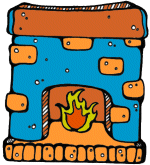|
Indoor Air Pollution
 Indoor air pollution can be a very serious problem.
You should be aware of the potential health hazards within
your home, and you should also know how to effectively reduce the levels of
air pollutants. Most people spend about 90% of their time indoors, so it
is extremely important to keep the indoor air clean! Indoor air pollution can be a very serious problem.
You should be aware of the potential health hazards within
your home, and you should also know how to effectively reduce the levels of
air pollutants. Most people spend about 90% of their time indoors, so it
is extremely important to keep the indoor air clean!
Respirable Particles
Respirable particles come from
wood stoves, fireplaces, kerosene heaters, and tobacco smoke. They can cause
eye, nose, and throat irritation, as well as respiratory infections and
ailments (such as bronchitis and lung cancer). There are several steps you
can take to reduce the health impacts of respirable particles:
- Don't use kerosene heaters
- Make sure exhaust fans that vent to the outside are installed on all gas
stoves
- Open the flues when you're using the fireplace
- Make sure there are no leaks on your wood stove
- Have your central heating system professionally inspected every year
- Don't keep cars running in the attached garage for very long
Volatile Organic Compounds
 Volatile organic compounds (or VOCs),
come from paints, solvents, wood preservatives, aerosol sprays, cleaners and
disinfectants, air fresheners, insect repellents, stored fuels, hobby supplies,
and dry-cleaned clothing. VOCs can cause eye, nose, and throat irritation,
headaches, nausea, and dizziness. Long term exposure is responsible for
damage to the kidneys, liver, and central nervous system. In addition, there
is some evidence that links VOCs to certain types of cancer. You can minimize
the impact of VOCs by following these steps:
Volatile organic compounds (or VOCs),
come from paints, solvents, wood preservatives, aerosol sprays, cleaners and
disinfectants, air fresheners, insect repellents, stored fuels, hobby supplies,
and dry-cleaned clothing. VOCs can cause eye, nose, and throat irritation,
headaches, nausea, and dizziness. Long term exposure is responsible for
damage to the kidneys, liver, and central nervous system. In addition, there
is some evidence that links VOCs to certain types of cancer. You can minimize
the impact of VOCs by following these steps:
- Use household products only as directed on the label
- Try to use the above products outdoors when possible
- If the products must be used indoors, make sure the area is well ventilated
- Only buy the above products in quantities that you will use quickly
- Try to use non-toxic alternatives
Formaldehyde
Formaldehyde is found mostly in wood
products, although it is also found in tobacco smoke, certain types of
insulation, and some drapes, textiles, and glues. It has similar health
effects to VOCs, but it can also cause fatigue, skin rashes, and severe
allergic reactions. The important steps to reduce your exposure to formaldehyde
are below:
- Use only pressed wood products that are labeled "exterior grade", because
the formaldehyde they contain doesn't escape as easily
- Keep your house at a low temperature and humidity to reduce the amount
of formaldehyde escaping from the above products
- Increase the ventilation in your home, especially if there are new sources
of formaldehyde in the house (example: new cabinets)
- If new carpet is installed, you should get a carpet pad with little or
no formaldehyde in it
Pesticides
 Pesticides can kill pests around the
house or yard, but they can also be harmful to us! They can irritate your
eyes, nose, and throat, and can cause damage to your central nervous system
and kidneys. They may also cause cancer. The following safety tips should
be followed: Pesticides can kill pests around the
house or yard, but they can also be harmful to us! They can irritate your
eyes, nose, and throat, and can cause damage to your central nervous system
and kidneys. They may also cause cancer. The following safety tips should
be followed:
- Use pesticides only as the label directs you to
- If the pesticides must be used indoors, make sure the area is well ventilated
- Apply only the amount needed -- no more
- If pesticides are used inside, remove any plants or pets from the area
- Try to use non-chemical methods of pest control
Lead
Lead is a heavy metal that comes from
lead-based paint and lead solder (sometimes used in plumbing pipes and connections).
If it is taken into the body, it can cause physical and mental underdevelopment
in fetuses and young children. It can also cause a decrease in coordination
and mental capability, and damage to the kidneys, nervous system, and blood cells.
The following tips will help reduce your exposure to lead:
- If you live in an older home, before removing paint you should have it
tested to see if it contains lead
- If there is lead-containing paint in your house, don't remove it! Cover
it with wallpaper
- If any soldering is done in your house, you should make sure it doesn't
contain any lead
Asbestos
Asbestos is found in some older
insulation and fireproofing materials. Prolonged exposure to asbestos
particles can cause cancer and lung diseases. Smokers are at a higher risk
to asbestos than non-smokers. If you live in an older home, be sure
to have professionals inspect your house before disturbing any potential
sources of asbestos.
Biological Pollutants
 Biological pollutants include molds,
mildews, bacteria, and small insects and other pests. They are found in damp
places, in bedding, and on pets. There are many illnesses that are associated
with biological pollutants, including respiratory irritations and some serious
diseases. Take the following steps to ensure that biological pollutants
are not a problem in your house: Biological pollutants include molds,
mildews, bacteria, and small insects and other pests. They are found in damp
places, in bedding, and on pets. There are many illnesses that are associated
with biological pollutants, including respiratory irritations and some serious
diseases. Take the following steps to ensure that biological pollutants
are not a problem in your house:
- Kitchen and bathrooms should be well vented
- Clothes dyer should be vented to the outside
- Humidifier should be cleaned daily
- Empty the water trays in air conditioners, humidifiers, and refrigerators
frequently
- Make sure wet carpets are dried thoroughly
- Make sure your basement has no leaks, and is well ventilated
- If you live in a very humid area, you should get a dehumidifier to keep
the humidity under 50%
Carbon Monoxide
 Carbon Monoxide (CO) comes from
incomplete burning. CO can come from all fuel-burning appliances (furnaces,
water heaters, stoves, ovens), as well as from fireplaces and wood stoves.
Car exhaust is also a major source of CO, as well as tobacco smoke. Carbon
monoxide can cause headaches, nausea, fatigue, blurred vision, rapid heart beat,
loss of muscle control, and flu-like symptoms. Breathing carbon monoxide can
be fatal. Please take the following precautions: Carbon Monoxide (CO) comes from
incomplete burning. CO can come from all fuel-burning appliances (furnaces,
water heaters, stoves, ovens), as well as from fireplaces and wood stoves.
Car exhaust is also a major source of CO, as well as tobacco smoke. Carbon
monoxide can cause headaches, nausea, fatigue, blurred vision, rapid heart beat,
loss of muscle control, and flu-like symptoms. Breathing carbon monoxide can
be fatal. Please take the following precautions:
- Keep gas appliances in your house adjusted correctly
- If possible, use only direct-vent or sealed combustion fuel-burning
appliances
- Don't use kerosene space heaters
- You should have an exhaust fan that vents outside for your gas stove
- Open flues in the fireplace when it's in use
- Make sure that your wood stove has no leaks
- A professional should inspect your central heating system every year
- Don't let a vehicle run in an attached garage
Nitrogen Dioxide
 Nitrogen dioxide (NO2) is
a gas produced by kerosene heaters, and unvented gas stoves. It is also a
component of tobacco smoke. NO2 can case eye, nose, and throat
irritation, and it may impair lung function in young children. The following
steps will decrease the effects of nitrogen dioxide in your home: Nitrogen dioxide (NO2) is
a gas produced by kerosene heaters, and unvented gas stoves. It is also a
component of tobacco smoke. NO2 can case eye, nose, and throat
irritation, and it may impair lung function in young children. The following
steps will decrease the effects of nitrogen dioxide in your home:
- Keep gas appliances in your house adjusted correctly
- If possible, use only direct-vent or sealed combustion fuel-burning
appliances
- Don't use kerosene space heaters
- You should have an exhaust fan that vents outside for your gas stove
- Open flues in the fireplace when it's in use
- Make sure that your wood stove has no leaks
- A professional should inspect your central heating system every year
Radon
Radon is a radioactive gas that comes
from the decay of uranium in the Earth. It comes up through cracks in the
ground and can get into your basement. It can accumulate in the basement
up to levels which can cause lung cancer. Smokers are at an
especially high risk of getting lung cancer from radon. There are several
steps you can take to reduce the effects of radon in your house:
- Have your house checked for radon
- Seal any cracks that may exist in your basement
- Make sure your basement has good ventilation
- Some well water may contain radon. It can be removed by aerating or using
an activated charcoal filter.
Environmental Tobacco Smoke
 Environmental tobacco smoke (or ETS)
comes from cigarettes, pipes, and cigars. It can cause eye, nose, and throat
irritation, as well as headaches, bronchitis, pneumonia, lung cancer, and
heart disease. It also increases the risk of respiratory and ear infections
in young children. This is the easiest type of indoor air pollution to get
rid of: don't allow smoking in your house.
Environmental tobacco smoke (or ETS)
comes from cigarettes, pipes, and cigars. It can cause eye, nose, and throat
irritation, as well as headaches, bronchitis, pneumonia, lung cancer, and
heart disease. It also increases the risk of respiratory and ear infections
in young children. This is the easiest type of indoor air pollution to get
rid of: don't allow smoking in your house.
|



This digital collection was produced under contract to Canada's Digital Collections program, Industry Canada. The web site was produced by a youth team at the Saskatchewan Lung Association.
